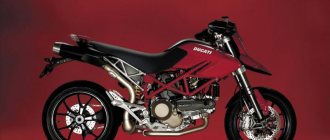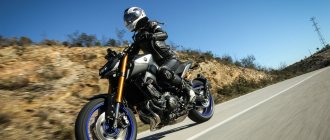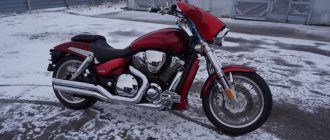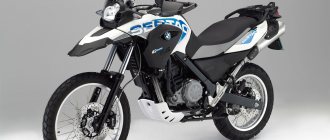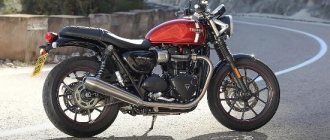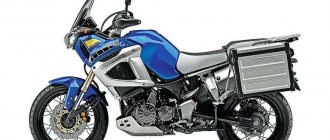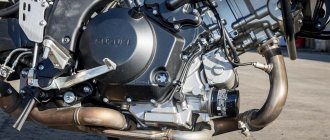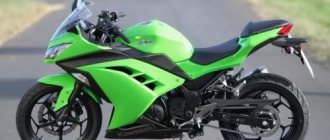Atypical V-shape: test drive Moto Guzzi V7 II Stone
Iron
Let’s start, perhaps, with the fact that it’s not “Gucci”, but “Guzzi” - let’s not confuse rags with iron. The surname, of course, is also Italian, but with different letters. By the way, the brand turns 95 this year, so there is no talk of any neophyte. It’s just that in Russia, motorcycles with a transverse V-twin were somehow unlucky with distribution. Maybe things will get better now? Last year, a completely new company, created specifically for this purpose by passionate and professional people, became responsible for the brand in Russia. Previously, it is worth recalling that the sale of Moto Guzzi in Russia was carried out by a certain Italian, whose main business was the sale of sanitary ware and tiles.
Moto Guzzi V7 Stone
Price from:
690,000 rubles
In a word, now everything has changed: the park has not only a beautiful showroom, but also testing equipment, and many years later I was able to take a motorcycle of this brand for a test. Moto Guzzi V7 performed by Stone is the starting model in the line into the world of the Italian brand. Outwardly, our “Italian” is very modest. Duplex steel frame, “telescope” with pipes of a very modest diameter (40 mm) at the front, and a pair of shock absorbers with only spring preload adjustment at the rear. Semi-matte black paint, cast black wheels... in a word, very laconic and without frills. It’s just the high reliefs of the cylinders protruding from the sides under the tank that make your eyes stop. Unusual, unusual, but still something very reminiscent of this whole structure.
A duplex frame, a voluminous engine crankcase with a gearbox docked at the rear, a driveshaft... well, of course, the layout of this power unit is almost identical to the boxer! The same crankshaft located longitudinally, one lower camshaft and valve drive through pushrods and rocker arms, and, by the way, there are two valves per cylinder... in a word, the layout solutions are exactly the same as those of the boxers. Only the cylinders proudly look into the sky, and do not “sag” parallel to the ground.
1 / 5
2 / 5
3 / 5
4 / 5
5 / 5
Of course, one cannot categorically call the motor archaic - only the traditional layout for the company connects it with the past. The unit is equipped with a fuel injection system and a catalytic converter in the exhaust system. According to the classification, it is short-stroke (cylinder diameter is 80 mm and piston stroke is 74 mm). It may not be called super-boosted, but this formula is enough for the engine to have good traction throughout the entire speed range and at the same time spin vigorously. 47 liters were removed from 744 cm³ of working volume. With. at 6,250 rpm and 59 Nm already at 3,000 rpm.
Moto Guzzi V7 Stone
engine capacity:
744 cm³
By the way, the similar parameters of the Irbit engine - yes, the Ural motorcycle engine - are very similar. I will not stop comparing these devices, because purely technically they are practically twins. Two cylinders, two valves per “pot”, lower camshaft, identical (744 versus 749 cm³) working volume, both have fuel injection, almost the same layout... Except that the Urals have a compression ratio that is one less: 8.6:1 versus 9.6:1, “square” engine with a stroke and piston diameter of 78 mm, but Irbit craftsmen will not get rid of the archaic four-speed gearbox. Moto Guzzi has six gears in its arsenal. Power varies slightly - 41 hp. With. the boxer has 47 hp. With. at V-shki. Torque – 57 versus 59 Nm, respectively. True, it is worth recognizing that the Ural - in this case we will consider the Retro Solo model as the closest in style - is 60 kg heavier: 249 kg of Russian “cast iron” versus 189 kg of Italian openwork.
1 / 3
2 / 3
3 / 3
Test drives / Single “Cast Iron-light”: test drive of the Harley-Davidson Street Glide Special More than half of all Harley-Davidson motorcycles sold in the United States (and this is the majority of HD production in principle) are representatives of the Touring family. Of course, first... 8431 0 3 08/09/2016
However, this is not a comparison test of two competitors, but a first look at Moto Guzzi, the Ural is here just for illustration. So, 189 kilograms is an enviable weight even for other sportbikes with aluminum frames and other carbon parts. Here we have far from the lightest engine design with a rather massive engine crankcase and gearbox, a steel frame and so on. In a word, the Italians managed to do it as usual - elegant, delicate and beautiful, but at the same time functional. Of course, to us, lovers of real “iron”, the abundance of plastic may seem ideologically unverified, but is anyone other than H.-D. And IMZ still makes “all-metal” motorcycles? Tea, the 21st century is here!
See and go
The motorcycle, in its dimensions and in its character, is suitable even for short young ladies. Everyone can reach the ground with their legs - the height of the saddle is only 790 mm. We saw, of course, lower, but the seat itself is quite narrow, so there will be no problems. And the small weight of the device is only good for your hand.
The dashboard is like hello from the 80s! Two completely classic types of round “alarm clocks”, a tachometer and a speedometer, topped with a bunch of completely ingenuously round “control” lamps. Except that the mechanical odometer here, of course, has given way to two electronic displays. True, everything here is also primitive - like on a calculator.
Two orange lamps, clumsily embedded in the upper crossmember next to the ignition switch, reveal the true year of birth of this motorcycle. These are ABS and MGCT “controls” - Moto Guzzi Controllo Trazione, or simply stabilization systems. Even five years ago you would have had to look for something like this! Returning to our Urals, the domestic boxer has still not got ABS, much less stabilizers, even though Brembo brakes have been installed on it for a long time.
1 / 2
2 / 2
An interesting feature: the V-shape, although equipped with a fuel injection system, requires warming up before starting. If you start immediately after starting a cold engine, the motorcycle will resist, sneeze, twitch and “not go” in the best traditions of carburetor technology from the end of the last century. Such is the “warm lamp” feature.
A couple of minutes at idle - and you can hit the road. On the move the bike feels very light. To be honest, the V7 is subjectively lighter than anything I’ve ridden in the last few years; motorcycles like the Bajaj Avenger or Yamaha MT-03 . But that is a completely different weight and cubic category. And here is a full-size motorcycle! Riding it around the city is a pleasure. The character of the engine, especially as long as you drive in a quiet mode, evokes warm memories of childhood and the old Ural, sawed into a “chopper”, in those moments when it worked and was not “sick”. The similar characteristics of the engines make these associations inevitable, but only until you open the gas.
As soon as the tachometer needle reaches o, the engine changes noticeably. The “herbivorous” exhaust sound gives way to a predatory bass roar (where did that bass come from!), and 74 “horses” give the light car very vigorous acceleration. Of course, this is not the dynamics of a liter sportbike, but you don’t expect this from a 750 cc V-twin with two valves per cylinder. As soon as you let off the gas, through the almost impenetrable “wall” of the catalyst and mufflers, a “shot” of the over-enriched mixture that has not burned out in the cylinders breaks through. Oh, if all these catalysts were torn out of the pipes and the “ends” were replaced with high-quality forward flow, there would be not a sound, but a song! But that’s why we have the basic version, so that everything here is orderly and simple. By the way, the list of options includes the “correct” pipes, and on more expensive trim levels they are even included as stock – so there is room for improvement. But even here, on the base Stone, if you keep the engine in good shape and don’t lower the tachometer needle to the first half of the range, you can drive quite cheerfully.
1 / 4
2 / 4
3 / 4
4 / 4
It's surprising that the steel frame, thin fork and equally delicate pendulum unexpectedly cope well with their duties. Of course, in fast turns and large angles you begin to feel a lack of chassis rigidity, but I must admit, I deliberately drove it into such modes in order to find the moment when the chassis begins to give up. In the more traditional driving modes for this device, the reserve of rigidity is abundant. Plus, you need to understand that the fairly high-profile stock Pirelli Sportdemon tires are not intended for sports activities, despite their name. But the brake mechanisms surprised me. The Moto Guzzi V7 is one of the very few machines that really only needs one disc on the front wheel. Obviously, this is due to the powerful four-piston Brembo caliper and the low weight of the device itself.
Moto Guzzi V7 II Stone
Brief technical specifications:
Dimensions, mm (L/H) 2,203 / 1,115 Power, l. pp.: 46.9 Frame: Tubular frame with double support als steel with removable elements Exhaust system: tri-catalytic converter with double lambda probe Gas distribution mechanism: two valves with light alloy pushers with balancers Fuel tank volume, l: 21
But the suspension was somewhat disappointing. There is some dissociation in the settings of the front and rear suspensions. If the fork is tuned quite softly, swallowing even quite large bumps and speed bumps with pleasure and “appetite”, then the “tail” shock absorbers are tuned very harshly. Every joint or crack in the asphalt is reliably transmitted to the pilot’s fifth point. Even “chubby” tires and the seat can’t save you! And metal thermal joints on overpasses and other more or less large irregularities have to be overcome by standing up on the steps, otherwise there will be trouble. It is not possible to adjust the stiffness of the shock absorbers: as I already wrote, there are no hydraulic adjustments. But, on the other hand, the V7 is an almost ready-made cafe racer. And at coffee shops, it’s not comfort that’s important, but speed and, of course, style.
1 / 2
2 / 2
By the way, the laconic appearance of this “gutsik” and the classical component of the design were tempting to make it a donor for the “coffee pot”. The only thing that stopped me was that the motorcycle was a test bike. If he were mine, he would go for welding and a grinder on the very first day of his appearance! After all, the V7 is truly an ideal preparation for a café racer! The lean silhouette shines through the black plastic! It is worth noting that the line includes a limited edition Racer. It seems to be the same model, but it looks like a million! But, in general, a cafe racer, like any custom, must be made by hand.
Summarizing
What's in the bottom line? Moto Guzzi V7 surprised. With its lightness and overall balance, the widest range of potential owners. Incredible charisma and “lampiness”, which is not found in the vast majority of modern technology. Not leaving associations with youth and the technology of this youth, but only in its best manifestations. And, of course, until the Moto Guzzi brand has reached its full potential in Russia, and motorcycles with a transverse V-twin really attract attention, they will be a great way to be known as an original and even an eccentric. What can we say about the price! A real “Italian” for that kind of money is almost fantastic. But only in reality.
New Moto Guzzi motorcycle debuted - updated V7
Moto Guzzi
| Tweet |
Moto GuzziItalian motorcycles
Italian manufacturer Moto Guzzi has introduced a new motorcycle - an updated version of the popular V7 model.
The new V7, as the company emphasizes in a press release, has become faster, more comfortable, better equipped and reconfigured, while maintaining the corporate identity and character of the brand.
This motorcycle is presented more than 50 years after the release of the first version and represents an important evolutionary step in the history of the V7.
The new device is available in two versions - V7 Stone, made in a minimalist style, and V7 Special - with classic and elegant shapes.
Also making its debut on the new V7 is a new Moto Guzzi engine, close to the one that powers the V85 TT race bike. This is the latest and most modern engine created in Mandello, which guarantees improved performance and maximum driving pleasure.
It is 25% more powerful than its predecessor - previously the maximum power was 52 hp. at 6,200 rpm, and now - 65 hp. at 6,800 rpm. The maximum torque has also increased - from 60 Nm at 4,250 rpm. up to 73 Nm at 5,000 rpm. At the same time, 80% of the torque is available already at 3,000 rpm.
The bike also has a wider rear wheel and a beefier pair of Kayaba shock absorbers. Plus - new, more stylish side panels and a smaller rear mud guard. And also a new exhaust system. And a new double seat.
The Moto Guzzi V7 Stone boasts a new all-LED headlight, a new instrument panel, digital, round in shape. The sport-style aluminum wheels are also new. The rear wheel, as already noted, is equipped with a wider 150/70 tire.
The Moto Guzzi V7 Special has an analog instrument panel with two round indicators (speedometer and tachometer) and ultra-classic spoked wheels.
The new V7 will also be available in a version with reduced engine power, tailored to Italian driving license requirements. The motorcycle also comes standard with the proprietary MGCT traction control system, which can be turned off.
V7 Stone is available in three color options - Nero Ruvido black, Azzurro Ghiaccio blue and Arancione Rame orange. The color options for the V7 Special are classic Blue Formale and Grigio Casual Gray.
| Tweet |
In order to leave a comment, you must log in or register!
Comments
More comments
Time Machine – Video review of Moto Guzzi V7III Stone
What is Moto Guzzi? Ask this question to Russian bottling motorcyclists and in most cases you will not get a clear answer. We have long and closely lived in the world of Honda, Yamaha, BMW, KTM, Harley-Davidson and other famous brands that have settled in the minds of consumers, like a thorn in a well-known place...
Those who managed to extract it know about Ducati, MV Agusta, Indian, Triumph, Aprilia and even Bimota... but even they in 90% of cases do not know about Moto Guzzi... Why is it an Italian brand with a 100-year history of less than two years? to this day remains little known and unclaimed in our country?
Unfortunately, there is no answer to this question... But in Italy, on the contrary, there is a cult of Moto Guzzi! There is not a single alley in this country, walking along which you will not see a classic motorcycle of the above-mentioned brand rushing past or parked.
Moto Guzzi is popular in the world, and for good reason... The brand, which dates back to 1921, has won tens of victories in the world championships and the still iconic Isle of Man TT race, and the first version of the specimen we received for testing , was introduced back in 1965.
Moto Guzzi V7III Stone, of course, has undergone a lot of changes, both technical and external, but somehow amazingly managed to preserve the spirit of that era.
The same duplex steel frame, almost the same transverse V-Twin, the power characteristics of which will make the modern generation laugh, cardan drive, air cooling, mechanical throttle drive... in short, everything that is so lacking in the products of modern motorcycle manufacturers churning out soulless but technologically advanced two-wheeled vehicles.
Okay, that's all lyrics, let's get to the point. At first glance, the basic version of V7III inspires little confidence, but at second glance, the situation does not change. There are fewer expectations from him than one would like, so there seems to be nothing to justify. And what can you expect from a 210-kilogram motorcycle with a cardan and an engine producing 52 hp and 60 Nm of torque?
That's right, you shouldn't expect miracles, especially if you pay attention to the usual 40 mm non-adjustable “telescope” at the front and a pair of simple Kayaba shock absorbers with preload adjustment...
Turn on the ignition, start the engine, let's go! The first thing that catches your eye is the dashboard screaming “Ahtung”, “Attention”, “Attention”, or in this case “Attenzione”, demanding to increase the gear.
Well, since there is no tachometer, as a class, in order to understand that there is still plenty of power reserve, it will take some time, why such precautions are not very clear, but these are trifles.
I was surprised that the seemingly flimsy chassis, originally from the 60s, is quite well built and does not raise any questions about the handling. Yes, it can “rearrange” at the junction, yes, this is not a track projectile, but at speeds up to 160 km/h everything is quite acceptable and does not cause any negativity, especially considering that the speed comfortable for it is still no more 130.
And at this speed you will only drive it on the highway and, by the way, at a consumption of just over 4 l./100 km. and a tank volume of 21 liters. you can go far enough.
Well, in the city, believe me, 80-100 km/h is what you need to understand it and enjoy a real classic, even if for the sake of modern standards, the Moto Guzzi V7III Stone is equipped with both ABS and 2-level traction control, and a smartphone can also be connected to it, which will allow you to turn a useless analog “alarm clock” into a full-fledged on-board computer.
But this is not the main thing, the main thing is that the Moto Guzzi V7III Stone is one of the few motorcycles that brings a sincere smile on your face at the moment of starting its engine, which will not leave you for a long time during its operation, which is worth quite a lot... A real time machine !
Tags
Moto Guzzi V7III Italian motorcycles cafe racer Tests and Reviews
